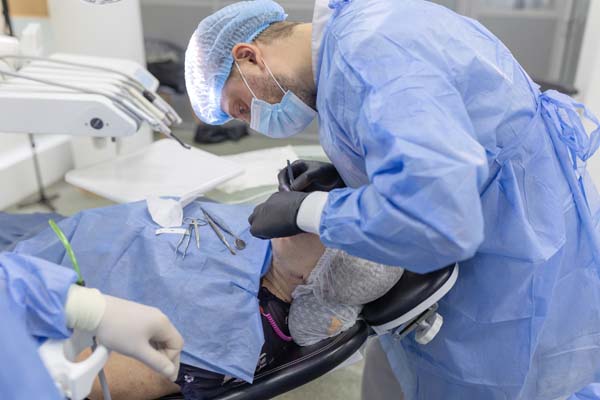Are Dental Bone Grafts Safe?

While a periodontal or gum disease can cause the degradation of teeth and the surrounding bone, there are ways to restructure the jawbone using a bone graft. Accomplished through a minor surgical procedure, grafting is generally safe and uses a material that encourages the development of new bone cells. The graft material, while typically made from processed bone minerals, can be sourced from one of several places:
- Animal donor
- Human donor
- Synthetic material
- The patient’s body
Typical procedures
Patients with periodontal disease may eventually notice the sagging of facial features because of bone loss. Grafting reduces the effect of sagging, and if used early on, it may eliminate any sign of facial sag. While grafting is mainly used to help people who suffer from periodontal disease, this type of dental surgery is beneficial in many situations for patients dealing with a wide array of issues.
Dental implants
Dental implants are another of the primary reasons for a bone graft. Implants require the insertion of a titanium post into the jawbone, which means that a healthy and dense bone is necessary for successful implantation. Therefore, if there is not enough volume or density, a dentist will likely recommend a graft to ensure proper placement.
Extractions
While it may seem strange to discuss grafting in terms of tooth extractions, it is actually a common practice today. When a tooth is removed, a dentist may opt to fill the void with a grafting material, ensuring no bone loss. Filling with grafting material also makes receiving an implant later easier as the preparation work has already been completed.
Salvaging
Bone and tooth loss due to periodontal disease is a common reason for grafting procedures. While patients diagnosed with this disorder may fear future losses, grafting is a way to slow down the effects of the disease. When bone loss begins to cause the loosening of teeth, a grafting solution can be injected around the teeth to help strengthen and support them, essentially slowing the process.
Surgery expectations
A grafting procedure is safe and is typically an outpatient procedure lasting only an hour or two, depending on the patient. While oral or intravenous sedatives can be used to increase patient relaxation, a graft can usually be placed using only local anesthesia.
Once the area has been prepared, the dentist makes a small incision in the gum tissue to access the bone. Then, using a needle, the graft material is injected into the site.
While many patients may experience some soreness around the incision site, the pain can be treated with over-the-counter pain relievers or anti-inflammatory medications. It is also recommended that patients use ice therapy to reduce swelling. The pain should only last a day or two. After several months the body should essentially reverse the bone loss by replacing the graft with its own bone.
Conclusion
To prevent the loss of bone caused by periodontal disease, patients can discuss a bone graft with their dentist. This type of procedure is safe and has been proven effective at reversing and preventing the negative effects of gum disease.
Request an appointment here: https://brighton.drjstearns.com or call Platte Valley Oral Surgery at (303) 997-0223 for an appointment in our Brighton office.
Check out what others are saying about our services on Yelp: Read our Yelp reviews.
Recent Posts
Wisdom teeth extractions are common procedures performed by an oral surgeon to prevent or address crowding, infection, and other complications associated with third molars. While the extraction itself is straightforward, proper care during the healing period supports a smooth recovery. With a few tips, patients can quickly recover from wisdom teeth extractions and avoid unnecessary…
Undergoing oral surgery can feel overwhelming, but proper post-operative care is crucial to ensure a smooth recovery. Whether you have had wisdom teeth removed, dental implants placed, or another procedure, following the right recovery steps can help minimize discomfort and prevent complications.First and foremost, the oral surgeon will provide detailed post-operative care instructions specific to…
Bone grafting is a surgical procedure that is done to rebuild bone loss or repair bone damage in the oral cavity. When a tooth is lost or removed from its socket, the alveolar bone supporting it starts to deteriorate, resulting in a gradual collapse of facial features. If this happens, a patient who opts for…
The TMJ, or the temporomandibular joint, connects the skull and lower jaw and is located by the ear. The joint functions like a hinge, enabling the jaw's movement for opening, closing, smiling, eating, and other mouth activities. If the jaw joint feels painful and is unable to perform its function, the cause could be what…


